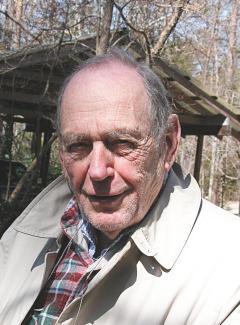The Bridge Blog
A dialog about our new bridge and these web pages
Overview. As a pointy-headed
university professor, my weekend project of bridge photography and
building these web pages generated many questions and introduced me
to just-in-time learning. I enjoy chasing my curiosity and
want to identify ways to encourage younger learners to also enjoy curiosity
chasing and learning.
Learning usually requires repetition while forgetting occurs when
I infrequently use information. Many young learners do not understand
the importance of repetition. Weekly visits to the bridge provided
the repetition necessary to detect changes in the bridge and
consequently generated
many questions and opportunities for learning. Over the course of the
bridge project, I had access to few experts for answering questions.
Rather than a liability, this became an asset and pushed me to improve
my search skills with Google. Soon, I found that answers
to questions encountered during my weekly photo shoots were often
only a Google-search away -
(see
Restoring the Joy in Learning). Consequently Google + Internet became
dependable extensions of my memory.
The bridge story is a work in progress and is evolving from a simple
collections of photographs to an experiment with Internet-centric
just-in-time learning.
Insights I gain from you
will find their way into the learning centers of MUSC.
Palmetto Bridge Constructors, a joint venture between
Tidewater
Skanska and
Flatiron Constructors, as well as
High Steel Structures,
Freyssinet, the
SCDOT and the
Federal Highway Commission Office
of Bridge Technology guided much of my learning.
I also learn from many of you and from Google-linked resources. More
important is the e-mail encouragement I receive from many of you.
Wed, 22 Jun 2005
June 22, 2005: About these web pages

On June 12, 2005,
Gene
Stead, 97 years of age, quietly died. Gene was Chairman
of Medicine at Duke from 1947 - 1967 and was my first boss. But he was more
than a chairman. He paid great attention to individuals, whether
faculty, students or patients, and worked at
enabling them to reach beyond their grasp. He understood that problems
could rarely be solved by technology alone and demonstrated over and over
again that success often rides on resolving personal and cultural issues.
Several years ago, my son, Josh, and I visited Gene for the weekend. Gene
was frustrated by the difficulties in maintaining communication with younger
people. We talked about the Internet, about Google, about what to learn
and how to avoid the
forgetting curve.
We shared our frustration that
many younger people have lost their curiosity and wrote a short paper about
restoring the joy in learning and about
learning and forgetting. I built his
web site as a tool for exploring
Internet-centric learning and addressing issues of curiosity and
forgetting. These pages about the building of
the new Cooper River Bridge (Ravenel bridge) reflect a continuation of
our explorations in learning, sharing and igniting curiosity among young
learners.
posted at: 08:25 | path:
|
permanent link to this entry
Fri, 17 Jun 2005
June 17, 2005: Exploring Graphical Navigation
I am often frustrated with the difficulty of finding stuff on
these web pages. I think there must be a better way. Jack, my son,
suggested some sort of graphical navigation. The idea is that you
can click on a region of an image and bring up more detailed photos.
I have built a rough draft
test page to develop this idea. There are about 2500 images
and finding what even I want, well, its simply out of control.
Perhaps a graphical interface with the photos is the way to do. Google
does this with Google Maps using
Ajax (asynchronous javascript and xml), a new web technology. This is
not
Ajax - just plain ordinary javascript - but a start.
I need your input, your ideas, your code, your whatever.
posted at: 13:21 | path: | permanent link to this entry
Mon, 13 Jun 2005
June 13, 2005 Humorous stories

From time to time, I receive some humorous stories of past experiences with
the Grace bridge. This seems like the best place to share them. To the right
you see (right to left) the Grace, Pearman and Ravenel bridges. Note the
steep incline associated with the older bridges. (Click the image for a larger
format.)
J. LaVerne Ard, former mayor of Pamplico, SC and VP of Marsh Lumber Company - circa 1950 story (as told by Bette Cox, Florence, SC):
"As a high school teenager, he drove a flatbed truck during the summer.
One trip to Charleston was for a load of fertilizer. Trying to come back
across the bridge with the flatbed fully loaded, a traffic light caught him,
and when it turned green, the truck simply wouldn't climb the grade.
He sent his little brother to the back of the truck to lay sacks of
fertilizer against the back wheels to keep from rolling back into the traffic
behind him. Then, along came a policeman.
The helpful policeman stopped all traffic, had him back up about two blocks
and rev the motor to get a running start, and cheered him on as the truck
chugged up the hill and on across the bridge."
Terry Edmonds, Apex NC
"When I was 15, in 1963, and had just gotten my learners permit to drive,
my father, sister and I drove from Wilmington, NC to Tampa, FL for Christmas.
I was driving on Hwy. 17 when we got to Mt. Pleasant. The old 2 lane bridge
into Charleston came as a very un"Pleasant" surprise. Dad just looked at me
and said that I was driving. Two way traffic on that old bridge was terrifying.
I must have left clear indentations on the steering wheel with both hands.
Never will forget it. And, I have told my kids the story so often that all of
them have reported back to me when they made their first trip across
'the bridge'. "
posted at: 10:00 | path:
|
permanent link to this entry
Thu, 09 Jun 2005
June 9 2005: Opening Dates Announced
|
Patiently waiting is not one of my virtues but I have learned that waiting
impatiently takes just as long. Here is the best information I have,
following an announcement from SCDOT today (June 9, 2005):
|
| July 9 Saturday afternoon |
Bridge Open for pedestrian strolling |
| July 10 Sunday afternoon |
Bridge Open for pedestrian strolling |
| July 11 Monday evening |
Fundraising event |
| July 14 Thursday evening |
Fireworks then stay-cable lighting |
| July 16 Saturday 9am |
Bridge Dedication and formal opening |
|
Other event times are a bit uncertain, but I shall post them as soon
as I find out
|
posted at: 10:00 | path:
|
permanent link to this entry
Wed, 08 Jun 2005
June 8 2005: A short web lesson:
 Managing a small web site is a challenge, a learning opportunity and
an opportunity to explore my Google-Internet memory amplifier.
In addition to the bridge web pages, I follow the lives of a few
spiders in our garden and built web pages which reveal a bit of their lives
(see Natasha or
mating banana spiders). Every morning I review the web access logs to
see what is happening.
Managing a small web site is a challenge, a learning opportunity and
an opportunity to explore my Google-Internet memory amplifier.
In addition to the bridge web pages, I follow the lives of a few
spiders in our garden and built web pages which reveal a bit of their lives
(see Natasha or
mating banana spiders). Every morning I review the web access logs to
see what is happening.
This morning I saw that Google-directed hits to our banana spider pages
are increasing and almost equal to the Google-directed hits to
our new Cooper River Bridge web pages.
What is the software base that enables me to manage these web pages?
I use the open source distribution of GNU-Linux
from RedHat
for my web server environment which includes
Apache as the web serving software.
For development, I use the GNU-Linux distribution from
the RedHat
sponsored Fedora project which also includes Apache. Finally, I use
Google to answer technical questions that
arise when I am building these web pages.
Apache writes an entry into either an access log or an error log each
time a web page is accessed. Monitoring the logs helps track web site
access patterns and identify errors that creep
into these web pages. To analyze the logs, I use
AWstats. This tracks
where web page requests originate and more important, summarizes the
search expressions
used to access web pages. From these data, I can directly see what is
interesting and what is never touched. This provides guidance for
experimenting with different ideas and determining how to better meet the
needs of readers.
Here is the table from the
summary of web activity since Sunday June 5.
| key phrases | Frequency | Percent |
| banana spider | 160 | 4.5 % |
| cooper river bridge | 128 | 3.6 % |
| new cooper river bridge | 52 | 1.4 % |
| ravenel bridge | 51 | 1.4 % |
| butterflys | 47 | 1.3 % |
| banana spiders | 41 | 1.1 % |
| forgetting | 31 | 0.8 % |
| french wildlife | 24 | 0.6 % |
| matrix calculus | 22 | 0.6 % |
| charleston bridge | 18 | 0.5 % |
| arthur ravenel bridge | 15 | 0.4 % |
| nernst-planck equation | 13 | 0.3 % |
| nephila clavipes | 13 | 0.3 % |
Note: I never know when I'll learn something new - and making this
blog entry provided
an unexpected surprise. When I first wrote the above, I had forgotten the
HTML tags for a table header - so I used
Google and the search words: how to make html table . The first
entry:
sorttable: Make all your tables sortable did not answer my question but
revealed a way to enable browser-based sorting of columns within a table.
Since this looked like a fun idea, I followed their recipe and suddenly
the colums in the above table became sortable.
The total time required for this experiment - 10 minutes.
Curious about other tricks available from this site, I
backed up a level
and found a collection of interesting
scripts for enabling other browser-based presentation features.
This is a typical example of the positive impact associated with
chasing curiosity within our Internet connected world.
posted at: 10:00 | path: | permanent link to this entry
Thu, 02 Jun 2005
June 2, 2005: The simple elegance of symmetry - without words
The real thing

A digital sketch

posted at: 10:00 | path:
|
permanent link to this entry







